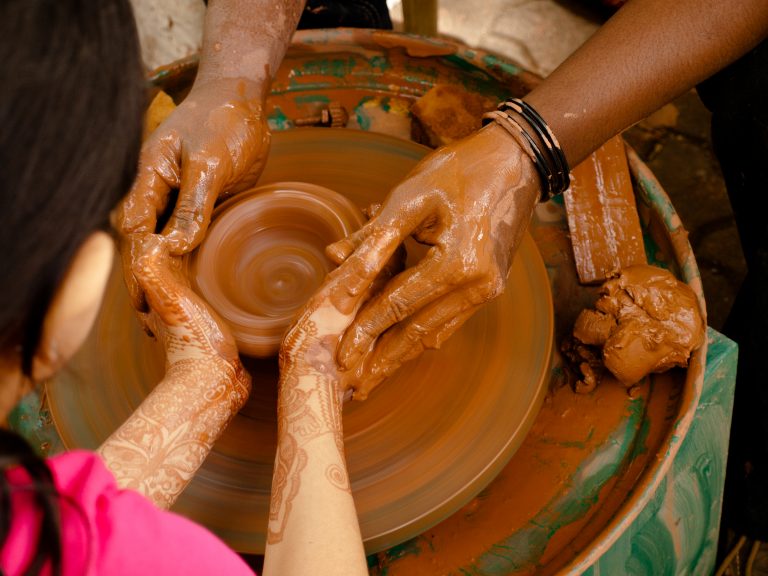
Image by Harini Calamur/Flickr, Attribution-NonCommercial-NoDerivs.
The Art of Learning Side-by-Side
Almost every year, I lead a spiritually oriented educational tour to another country. This April, we hope to head to Morocco. Preparing for this year’s journey has brought back my experience of living in Morocco some twenty years ago and a scene that still has me thinking and rethinking what a more robust form of spiritual life may look like. In particular, it has made me reflect on why we need something more rigorous than “self-help.”
I still remember the scene so vividly. I was walking through Fez, one of the beautifully preserved medieval cities of the world. The Souq (bazaar, market) features many artists and craftsmen who practice their crafts as they have been for centuries. Wood-workers, leather-workers, smiths, carpet-weavers, jewelry makers, and more. The artisan who caught my eye on that day was a comb-maker.
The comb-maker was an old man with a kind, leathery face. He was wearing a long robe, the kind that was common in Morocco then and now, and looks amazingly like a Jedi robe. Of course Jedis are Sufis, as we all know.
He was working with bones, I think. This is one of the qualities that I have come to appreciate about traditional cultures. If they eat meat, they use every part of the animal. The hide is used to make leather. The bones are used for combs and other material.
The comb-maker had the bone in one hand and a small chisel in the other. He carefully chiseled away at the bone and slowly, slowly, the inner comb appeared from the bone. He was masterful. No effort was wasted, nothing was exaggerated. It was like watching a violin player. The motions were rhythmical. It was spell-binding.
It was only later that I noticed the young boy, almost hidden behind the comb-making maestro. He was young, maybe 12 or 14 years old, with a hint of a mustache. He was spell-bound, observing the master at work. His eyes were fixated respectfully, even reverentially, on the maestro. His eyes did not waver nor did he become distracted.
When the maestro was done with the bone, he picked up a left over piece and handed it to the young boy. Then he handed him the chisel. The boy raised his glance and made eye contact with the master. The maestro smiled and gave him a knowing nod. The boy, somewhat uncertain, took the chisel, and started to make his marks on the bone. His marks were not quite as rhythmical or precise as the master’s, but not far off either. He paused after four or five strikes and looked again at the master. The master took the boy’s wrist and very subtly adjusted the young boy’s grip. Another knowing smile. The boy chiseled again four or five strikes. Again he looked up at the maestro. An even kinder, bigger smile. Another approving nod.
It was magical and yet so commonplace. It was a scene that I imagine has been played in countless artisan shops, between untold numbers of masters and apprentices. I was watching training in progress.
The boy would not always remain an apprentice. He would stay long enough to learn the craft, the tools of the trade, and eventually he would have his own shop. Someday, the apprentice would become a master, and he too would train his own apprentices. That is the way of traditional crafts and the way of the spirit. It is not about permanent hierarchy but simply about the passing on of a skill-set. It was all about the watching, the learning, the slight correction of the wrist, the trust, and the knowing smile.
The desire for mentors, masters, maestros, and gurus has never disappeared from any of our cultures. Yes, we are all — and rightly so — suspicious of spiritual authority today. (Especially of male spiritual authorities, and rightly so.) But the more that we see abuses of authority (financially, spiritually, sexually, etc.), there still remains the quiet cry for a Gandalf here, a Dumbledore there, a Yoda awaiting us even further. We still want our comb-maker maestros of the spirit to take us by the hand, correct our wrist, teach us the craft of the heart, and walk with us on the path. Not to walk for us but to walk with us, side by side. We want to know that they have walked on this path before, they know how to hold the chisel that brings a luminous soul out of this unfinished heart journey.
That seems to me to be one of the elements that is missing from our culture of self-help. I understand that many of us have been turned off by abusive priests, rabbis, imams, shamans, and gurus. And so many see the institutions of religion as standing in the way of a genuine meaningful spiritual life. But somewhere between “self-help” and “institutionalized religion” there is a missing step, and that step, partially, is the comb-maker.

